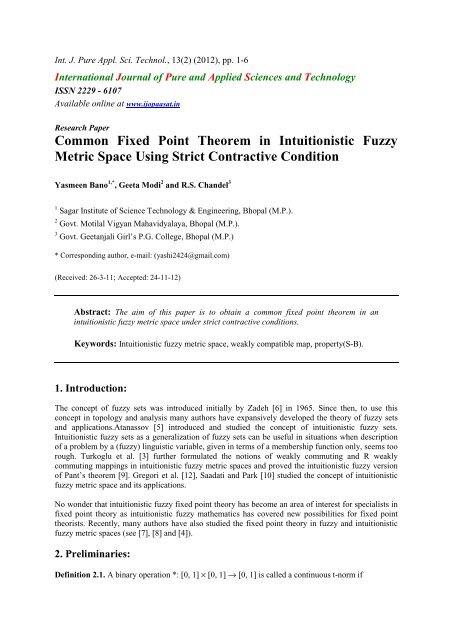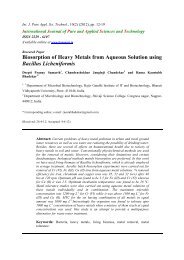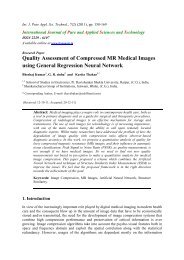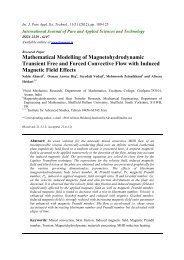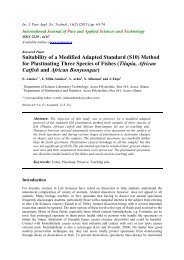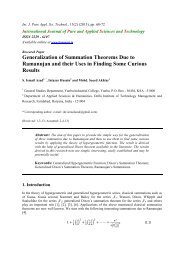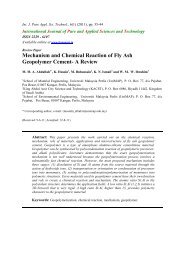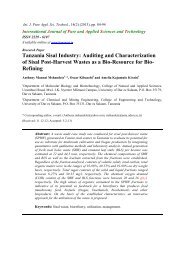Common Fixed Point Theorem in Intuitionistic Fuzzy Metric Space ...
Common Fixed Point Theorem in Intuitionistic Fuzzy Metric Space ...
Common Fixed Point Theorem in Intuitionistic Fuzzy Metric Space ...
- No tags were found...
You also want an ePaper? Increase the reach of your titles
YUMPU automatically turns print PDFs into web optimized ePapers that Google loves.
Int. J. Pure Appl. Sci. Technol., 13(2) (2012), pp. 1-6<br />
International Journal of Pure and Applied Sciences and Technology<br />
ISSN 2229 - 6107<br />
Available onl<strong>in</strong>e at www.ijopaasat.<strong>in</strong><br />
Research Paper<br />
<strong>Common</strong> <strong>Fixed</strong> <strong>Po<strong>in</strong>t</strong> <strong>Theorem</strong> <strong>in</strong> <strong>Intuitionistic</strong> <strong>Fuzzy</strong><br />
<strong>Metric</strong> <strong>Space</strong> Us<strong>in</strong>g Strict Contractive Condition<br />
Yasmeen Bano 1,* , Geeta Modi 2 and R.S. Chandel 3<br />
1 Sagar Institute of Science Technology & Eng<strong>in</strong>eer<strong>in</strong>g, Bhopal (M.P.).<br />
2 Govt. Motilal Vigyan Mahavidyalaya, Bhopal (M.P.).<br />
3 Govt. Geetanjali Girl’s P.G. College, Bhopal (M.P.)<br />
* Correspond<strong>in</strong>g author, e-mail: (yashi2424@gmail.com)<br />
(Received: 26-3-11; Accepted: 24-11-12)<br />
Abstract: The aim of this paper is to obta<strong>in</strong> a common fixed po<strong>in</strong>t theorem <strong>in</strong> an<br />
<strong>in</strong>tuitionistic fuzzy metric space under strict contractive conditions.<br />
Keywords: <strong>Intuitionistic</strong> fuzzy metric space, weakly compatible map, property(S-B).<br />
1. Introduction:<br />
The concept of fuzzy sets was <strong>in</strong>troduced <strong>in</strong>itially by Zadeh [6] <strong>in</strong> 1965. S<strong>in</strong>ce then, to use this<br />
concept <strong>in</strong> topology and analysis many authors have expansively developed the theory of fuzzy sets<br />
and applications.Atanassov [5] <strong>in</strong>troduced and studied the concept of <strong>in</strong>tuitionistic fuzzy sets.<br />
<strong>Intuitionistic</strong> fuzzy sets as a generalization of fuzzy sets can be useful <strong>in</strong> situations when description<br />
of a problem by a (fuzzy) l<strong>in</strong>guistic variable, given <strong>in</strong> terms of a membership function only, seems too<br />
rough. Turkoglu et al. [3] further formulated the notions of weakly commut<strong>in</strong>g and R weakly<br />
commut<strong>in</strong>g mapp<strong>in</strong>gs <strong>in</strong> <strong>in</strong>tuitionistic fuzzy metric spaces and proved the <strong>in</strong>tuitionistic fuzzy version<br />
of Pant’s theorem [9]. Gregori et al. [12], Saadati and Park [10] studied the concept of <strong>in</strong>tuitionistic<br />
fuzzy metric space and its applications.<br />
No wonder that <strong>in</strong>tuitionistic fuzzy fixed po<strong>in</strong>t theory has become an area of <strong>in</strong>terest for specialists <strong>in</strong><br />
fixed po<strong>in</strong>t theory as <strong>in</strong>tuitionistic fuzzy mathematics has covered new possibilities for fixed po<strong>in</strong>t<br />
theorists. Recently, many authors have also studied the fixed po<strong>in</strong>t theory <strong>in</strong> fuzzy and <strong>in</strong>tuitionistic<br />
fuzzy metric spaces (see [7], [8] and [4]).<br />
2. Prelim<strong>in</strong>aries:<br />
Def<strong>in</strong>ition 2.1. A b<strong>in</strong>ary operation *: [0, 1] × [0, 1] → [0, 1] is called a cont<strong>in</strong>uous t-norm if
Int. J. Pure Appl. Sci. Technol., 13(2) (2012), 1-6 2<br />
([0, 1], *) is an abelian topological monoid with the unit 1,<br />
such that a * b ≤ c * d whenever a ≤ c and b ≤ d.<br />
For all a, b, c, d ∈[0, 1].<br />
Examples of t-norm are a*b = ab and a*b = m<strong>in</strong> {a, b}.<br />
Def<strong>in</strong>ition 2.2. A b<strong>in</strong>ary operation ◊: [0, 1] × [0, 1] → [0, 1] is a cont<strong>in</strong>uous t-conorm if ◊ it satisfies<br />
the follow<strong>in</strong>g conditions:<br />
(a) ◊ is commutative and associative;<br />
(b) ◊is cont<strong>in</strong>uous;<br />
(c) a ◊0=a;<br />
(d) a ◊b ≤ c ◊d whenever a ≤ c and b ≤ d,<br />
For all a, b, c, d ∈ [0, 1].<br />
Def<strong>in</strong>ition 2.3. A 5-tuple (X, M, N, *, ◊) is said to be an <strong>in</strong>tuitionistic fuzzy metric space<br />
(shortly IFM-space) if X is an arbitrary set, * is a cont<strong>in</strong>uous t-norm, ◊ is a cont<strong>in</strong>uous t-conorm and<br />
M, N are fuzzy sets on X 2 × (0, ∞)satisfy<strong>in</strong>g the follow<strong>in</strong>g conditions :<br />
For all x, y, z ∈ X and s, t > 0;<br />
(IFM-1) M(x, y, t)+N (x, y, t) ≤1;<br />
(IFM-2) M(x, y, 0) = 0;<br />
(IFM-3) M(x, y, t)=1 if and only if x = y;<br />
(IFM-4) M(x, y, t)=M(y, x, t);<br />
(IFM-5) M(x, y, t) * M (y, z, s) ≤ M(x, z, t + s);<br />
(IFM-6) M(x, y, .):[0, ∞) → [0, 1] is left cont<strong>in</strong>uous;<br />
(IFM-7) lim t →∞ M (x, y, t)=1;<br />
(IFM-8) N(x, y, 0) = 1;<br />
(IFM-9) N(x, y, t)=0 if and only if x = y;<br />
(IFM-10) N(x, y, t)=N(y, x, t);<br />
(IFM-11) N(x, y, t) ◊N (y, z, s) ≥N (x, z, t + s);<br />
(IFM-12) N(x, y,.):[0, ∞) → [0, 1] is right cont<strong>in</strong>uous;<br />
(IFM-13) lim t →∞ N (x, y, t) = 0;<br />
Then (M, N) is called an <strong>in</strong>tuitionistic fuzzy metric on X. The functions M (x, y, t) and N(x, y, t)<br />
denote the degree of nearness and degree of non-nearness between x and y with respect to t,<br />
respectively.<br />
Lemma 2.4. Let (X, M, N, *, ◊) be an <strong>in</strong>tuitionistic fuzzy metric space and for all x, y ∈ X, t > 0 and<br />
if for a number k∈ (0, 1),<br />
M(x, y, kt) ≥ M(x, y, t) and N(x, y, kt) ≤ N(x, y, t)<br />
Then x =y.<br />
Def<strong>in</strong>ition 2.5. Let A and B be maps from an <strong>in</strong>tuitionistic fuzzy metric space (X, M, N, *, ◊) <strong>in</strong>to<br />
itself. Then the maps A and B are said to be compatible if, for all t>0<br />
lim n →∞ M (ABx n ,BAx n ,t)=1, lim n →∞ N (ABx n ,BAx n ,t)=0,<br />
Whenever {x n } is a sequence <strong>in</strong> X such that lim n →∞ Ax n = lim n →∞ Bx n = z, for some z ∈ X.<br />
Def<strong>in</strong>ition 2.6. Two self maps A and B are said to be weakly compatible if they commute at their<br />
co<strong>in</strong>cidence po<strong>in</strong>ts.<br />
Def<strong>in</strong>ition 2.7. Let A and B be two self mapp<strong>in</strong>gs of an <strong>in</strong>tuitionistic fuzzy space (X, M, N, *, ◊). We<br />
say that A and B satisfy the property (S-B) if there exists a sequence {x n } <strong>in</strong> X such that<br />
lim n →∞ Ax n = lim n →∞ Bx n = z ,for some z ∈ X.<br />
Example 2.8. Let X=[0, + ∞). Def<strong>in</strong>e A, B : X → X by<br />
Bx= x / 4 and Ax = 3x / 4, ∀ x ∈ X.
Int. J. Pure Appl. Sci. Technol., 13(2) (2012), 1-6 3<br />
Consider the sequence x n = 1/n, clearly lim n →∞ Ax n = lim n →∞ Bx n =0.<br />
Then A and B satisfy property (S-B).<br />
Example 2.9. Let X = [2, + ∞). Def<strong>in</strong>e A, B : X → X by<br />
Bx = x + 1/2 and Ax = 2x + 1/2, ∀ x ∈ X.<br />
Suppose property (S-B) holds<br />
Then there exists a sequence {x n } <strong>in</strong> X satisfy<strong>in</strong>g<br />
lim n →∞ Ax n = lim n →∞ Bx n = z, for some z ∈ X<br />
Therefore lim n →∞ x n = z – 1/2 and lim n →∞ x n = (2z – 1) / 4.<br />
Then z = 1/2<br />
Which is a contradiction s<strong>in</strong>ce 1/2 ∉ X.<br />
Hence A and B do not satisfy the property (S-B).<br />
3. Ma<strong>in</strong> Results:<br />
<strong>Theorem</strong>. Let (X, M, N,*, ⟡) be an <strong>in</strong>tuitionistic fuzzy metric space with t*t ≥ t for some t ∈ [0, 1]<br />
and the condition (IFM-7 and IFM-13).Let A, B, S and T be mapp<strong>in</strong>gs of X <strong>in</strong>to itself such that<br />
(i) A(X) ⊂ T(X) and B(X) ⊂ S(X)<br />
(ii) (A,S) or (B,T) satisfies the property (S-B)<br />
(iii) There exists a number k ∈ (0,1), such that:<br />
M(Ax, By, kt) ≥ M(Sx, Ty, t) * M (Sx, By, t) * M (Ty, By, t)<br />
N(Ax, By, kt) ≤ N(Sx, Ty, t) ⟡ N (Sx, By, t) ⟡ N (Ty, By, t)<br />
(iv) (A,S) and (B,T) are weakly compatible<br />
(v) One of A(X), B(X), S(X) or T(X) is a closed subset of X<br />
Then A, B, S and T have a unique common fixed po<strong>in</strong>t <strong>in</strong> X.<br />
Proof. Suppose that (B,T) satisfies the property (S-B).<br />
Then there exists a sequence {x n } <strong>in</strong> X such that<br />
lim n→∞ Bx n = lim n→∞ Tx n = z<br />
For some z ∈ X<br />
S<strong>in</strong>ce B(X) ⊂ S(X)<br />
There exists a sequence {y n } <strong>in</strong> X, such that<br />
Bx n = Sy n<br />
Hence<br />
lim n→∞ Sy n = z<br />
Let us show that<br />
lim n→∞ Ay n = z<br />
Indeed, <strong>in</strong> view of (iii), we have<br />
M(Ay n , Bx n , kt) ≥ M(Sy n , Tx n , t) * M (Sy n , Bx n , t) * M (Tx n , Bx n , t)<br />
≥ M(Bx n , Tx n , t) * 1 * M (Tx n , Bx n , t)<br />
≥ M(Tx n , Bx n , t)<br />
N (Ay n , Bx n , kt) ≤ N (Sy n , Tx n , t) ⟡ N (Sy n , Bx n , t) ⟡ N (Tx n , Bx n , t)<br />
≤ N(Bx n , Tx n , t) ⟡ 0 ⟡N (Tx n , Bx n , t)<br />
≤ N(Tx n , Bx n , t)<br />
It follows that
Int. J. Pure Appl. Sci. Technol., 13(2) (2012), 1-6 4<br />
lim n→∞ M(Ay n ,Bx n , kt) ≥ 1<br />
lim n→∞ N(Ay n ,Bx n , kt) ≤ 0<br />
Which implies that<br />
lim n→∞ M(Ay n ,Bx n ,kt) = 1<br />
lim n→∞ N (Ay n ,Bx n , kt) = 0<br />
And we deduce that<br />
lim n→∞ Ay n = z<br />
Suppose S(X) is a closed subset of X.<br />
Then z = Su, for some u ∈ X<br />
Subsequently, we have<br />
lim n→∞ Ay n = lim n→∞ Bx n = lim n→∞ Tx n = lim n→∞ Sy n = Su<br />
By (iii), we have<br />
M(Au, Bx n , kt) ≥ M(Su, Tx n , t) * M (Su, Bx n , t) * M (Tx n , Bx n , t)<br />
N(Au, Bx n , kt) ≤ N(Su, Tx n , t) ⟡N (Su, Bx n , t) ⟡ N (Tx n , Bx n , t)<br />
Tak<strong>in</strong>g limit n → ∞, we obta<strong>in</strong> Au = Su<br />
The weak compatibility of A and S implies that ASu = SAu<br />
And then AAu = ASu = SAu = SSu<br />
On the other hand, s<strong>in</strong>ce A(X) ⊂ T(X)<br />
There exists a po<strong>in</strong>t v ∈ X, such that Au = Tv<br />
We claim that Tv = Bv<br />
Us<strong>in</strong>g (iii), we have<br />
M(Au, Bv, kt) ≥ M(Su, Tv, t) * M (Su, Bv, t) * M (Tv, Bv, t)<br />
≥ M(Au, Bv, t)<br />
N(Au, Bv, kt) ≤ N(Su, Tv, t) ⟡ N (Su, Bv, t) ⟡ N (Tv, Bv, t)<br />
≤ N(Au, Bv, t)<br />
By Lemma 2.4, we have Au = Bv<br />
Thus Au = Su = Tv = Bv<br />
The weak compatibility of B and T implies that BTv = TBv<br />
And TTv = TBv = BTv = BBv<br />
Let us show that Au is a common fixed po<strong>in</strong>t of A, B, S and T.<br />
In view of (iii), it follows that<br />
M(Au,AAu, kt) = M(AAu, Bv, kt)<br />
≥ M(SAu, Tv, t) * M (SAu, Bv, t) * M (Tv, Bv, t)<br />
≥ M(AAu, Au, t)<br />
N(Au,AAu, kt) = N(AAu, Bv, kt)<br />
≤ N(SAu, Tv, t) ⟡ N (SAu, Bv, t) ⟡ N (Tv, Bv, t)<br />
≤ N(AAu, Au, t)<br />
Therefore by Lemma 2.4, we have<br />
Au = AAu = SAu
Int. J. Pure Appl. Sci. Technol., 13(2) (2012), 1-6 5<br />
And Au is a common fixed po<strong>in</strong>t of A and S.<br />
Similarly, we prove that Bv is a common fixed po<strong>in</strong>t of B and T.<br />
S<strong>in</strong>ce<br />
Au = Bv<br />
We conclude that Au is a common fixed po<strong>in</strong>t of A, B, S and T.<br />
The proof is similar when T(X) is assumed to be closed subset of X.<br />
The cases <strong>in</strong> which A(X) or B(X) is closed subset of X are similar to the cases <strong>in</strong> which T(X) or S(X),<br />
respectively, is closed.<br />
S<strong>in</strong>ce A(X) ⊂ T(X) and B(X) ⊂ S(X)<br />
If Au = Bu = Su = Tu = u<br />
And Av = Bv = Sv = Tv = v<br />
Then by (iii), we have<br />
M(u,v, kt) = M(Au, Bv, kt)<br />
≥ M(Su, Tv, t) * M (Su, Bv, t) * M (Tv, Bv, t)<br />
≥ M(u, v, t)<br />
N(u,v, kt) = M(Au, Bv, kt)<br />
≤ N(Su, Tv, t) ⟡ N (Su, Bv, t) ⟡ N (Tv, Bv, t)<br />
≤ N(u, v, t)<br />
By Lemma 2.4, we have u = v and the common fixed po<strong>in</strong>t is unique.<br />
This completes the proof of the theorem.<br />
We now give an example to illustrate the above theorem.<br />
Example Let X = [0, 2] and(X,M,N, *,⟡) be an <strong>in</strong>tuitionistic fuzzy metric<br />
M (Ax, By, t) = ____t____ ; N(Ax, By, t) = |x − y|<br />
t + |x - y| t + |x − y|<br />
For all x,y ∈ X and<br />
Def<strong>in</strong>e A, B, S, T : X → X by<br />
0 if x = 0 0 if x = 0<br />
Ax = ; Bx =<br />
0.15 if x > 0 0.35 if x > 0<br />
0 if x = 0 0 if x = 0<br />
Sx = 0.3 if 0 < x ≤ 0.5 and Tx = 0.15 if 0 < x ≤ 0.5<br />
x-0.35 if x > 0.5 x - 0.15 if x > 0.5<br />
If we take k = 0.5 and t = 1, we see that A, B, S, and T satisfy all the conditions of the above theorem<br />
and have a unique common fixed po<strong>in</strong>t 0 ∈ X. It may be noted <strong>in</strong> this example that the mapp<strong>in</strong>gs A<br />
and S commute at their co<strong>in</strong>cidence po<strong>in</strong>t 0 ∈ X. So A and S are weakly compatible maps. Similarly<br />
B and T are weakly compatible maps.<br />
References<br />
[1] B. Schweizer and A. Sklar, Statistical metric spaces, Pacific J. Math., 10(1960), 314-334.<br />
[2] C. Alaca, D. Turkoglu and C. Yildiz, <strong>Fixed</strong> po<strong>in</strong>ts <strong>in</strong> <strong>in</strong>tuitionistic fuzzy metricspaces, Chaos,<br />
Solitons & Fractals, 29(5) (2006), 1073-1078.
Int. J. Pure Appl. Sci. Technol., 13(2) (2012), 1-6 6<br />
[3] D. Turkoglu, C. Alaca, Y.J. Cho and C. Yildiz, <strong>Common</strong> fixed po<strong>in</strong>t theorems <strong>in</strong> <strong>in</strong>tuitionistic<br />
fuzzy metric spaces, J. Appl. Math. & Comput<strong>in</strong>g, 22(2006), 411-424.<br />
[4] J.H. Park, <strong>Intuitionistic</strong> fuzzy metric spaces, Chaos, Solitons & Fractals, 22(2004), 1039-<br />
1046.<br />
[5] K. Atanassov, <strong>Intuitionistic</strong> fuzzy sets, <strong>Fuzzy</strong> Sets and System, 20(1986), 87-96.<br />
[6] L.A. Zadeh, <strong>Fuzzy</strong> sets, Inform. and Control, 8(1965), 338-353.<br />
[7] M. Grabiec, <strong>Fixed</strong> po<strong>in</strong>ts <strong>in</strong> fuzzy metric spaces, <strong>Fuzzy</strong> Sets and Systems, 27(1988), 385-389.<br />
[8] M. Imdad and J. Ali, Some common fixed po<strong>in</strong>t theorems <strong>in</strong> fuzzy metric spaces,<br />
Mathematical Communication, 11(2006), 153-163.<br />
[9] R.P. Pant, <strong>Common</strong> fixed po<strong>in</strong>ts of noncommut<strong>in</strong>g mapp<strong>in</strong>gs, J. Math. Anal. Appl.,<br />
188(1994), 436-440.<br />
[10] R. Saadati and J.H. Park, On the <strong>in</strong>tuitionistic fuzzy topological spaces, Chaos, Solitons &<br />
Fractals, 27(2006), 331-344.<br />
[11] S. Sharma, S. Kutukcu and R.S. Rathore, <strong>Common</strong> fixed po<strong>in</strong>t for multivalued mapp<strong>in</strong>gs <strong>in</strong><br />
<strong>in</strong>tuitionistic fuzzy metric space, Communication of Korean Mathematical Society, 22(3)<br />
(2007), 391-399.<br />
[12] V. Gregori, S. Romaguera and P. Veeramani, A note on <strong>in</strong>tuitionistic fuzzy metric spaces,<br />
Chaos, Solitons & Fractals, 28(2006), 902-905.


